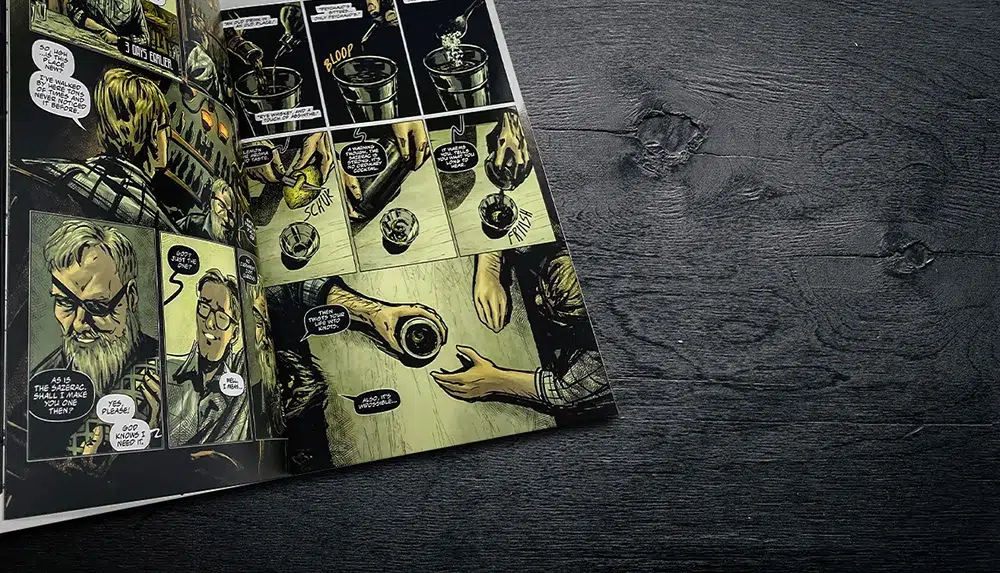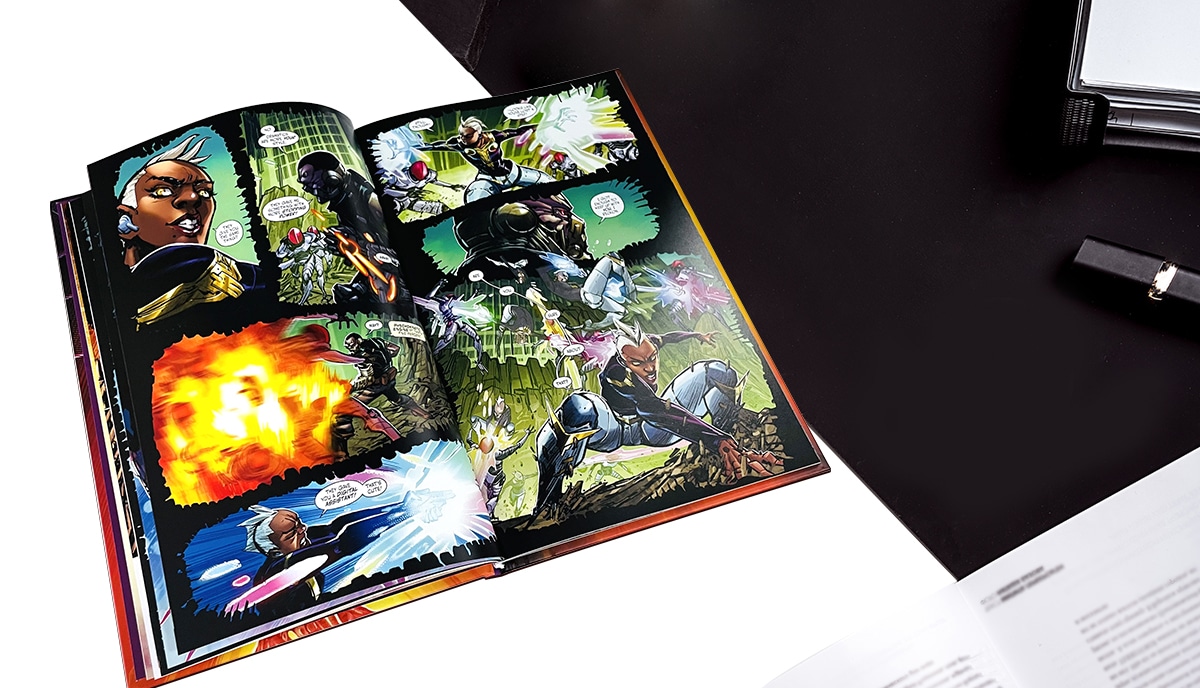Based on over 25 years of success printing manga for mainstream and independent publishers, we share how to design, publish, and sell your manga comics

Are you an aspiring mangaka—a manga artist or writer—eager to bring your stories to life, share them with the world, and make a part-time or full-time income from your work? One of the best ways to achieve this dream is to design, self-publish, and sell your manga as an independent artist. While it may seem daunting at first, with some research, creativity, and hard work, you can create a professional and engaging series of manga that will resonate with readers, build a fanbase, and generate income. While we can't guarantee your success, drawing on over 25 years' experience in the industry, we can help you get off to a great start. In this comprehensive guide, we'll cover the following important topics:
Planning and storyboarding
Before diving into the world of manga creation, you need to plan out your story and characters. Start by brainstorming ideas for your plot, setting, and characters, and make notes on their backgrounds, motivations, and appearances. The same principles of storytelling and narrative creation that apply to a short story, a novel, or other forms of fiction, apply to comics, graphics novels, and manga, too.
So, you need a well-defined protagonist who has a clear aim, a powerful motive, and a burning desire to achieve something. You then need to figure out what they'll try to do to achieve their goal and create an antagonist (which could be a person, an idea, or an external force) which places obstacles in their path. The plot comes out of what they do to overcome those obstacles, why they repeatedly fail at first, how they change as a person in response to these experiences, and how that process of change ultimately leads them to win. This will give you a solid foundation to build upon when designing your manga.
Once you have a clear idea of your story, it's time to create storyboards. This involves sketching out the panels and laying out the action. Remember that, while you may have written a lot of words when figuring out and planning your story outline, manga is primarily a visual medium. Try to tell your story as entirely as possible in the images.
Focus on the flow of the story and how each panel contributes to the overall narrative. This process will help you visualize how your manga will look and make it easier to move on to the next steps. But don't expect to get your storyboard right the first time. You'll probably need to change it, re-order some events, take different perspectives, and alter aspects of the story as you go along. That's why you shouldn't waste time and energy on detailed artwork at the storyboarding stage. Rough sketches, or even stick figures, will do at this stage.
Writing and scripting
After storyboarding, it's time to write the script for your manga. This includes crafting the content of speech bubbles, thought bubbles, captions, descriptions, and any other text that will appear throughout your work. Make sure each character has a distinct voice, and that any dialogue is trimmed to its essential impact and always helps to drive the story forward. Also, consider how the text interacts with the visuals and ensure that it doesn't obstruct or distract from the artwork.
In fact, once you have the textual elements of your manga clear, go back and incorporate them into your storyboard. The positioning, size, and shape of speech and thought bubbles, narrative, links, and captions need a lot of thought. The text should become an integral part of page design, not something “tacked on” after the artwork.
Character design and artwork
Once you have your story and script in place, and you've decided on the layouts of each frame and page—including the text and dialogue—it's time to focus on designing your characters and creating the artwork. You can either draw the art yourself or collaborate with a professional graphic artist with experience in the genre. If you're working with an artist, communicate your ideas clearly and establish want you want from each aspect of the artwork, such as drawing, inking, or coloring. The relationship between writer and artist should be a productive and creative one, based on a willingness to be open to ideas and engage in a purposeful collaboration.
When creating the artwork, try to express the diversity of your characters and changes in atmosphere and location without losing an overall sense of cohesion. If it's the first time you've created a manga, take time to try experimenting with different techniques, such as shading or coloring, perspective, close-ups and wider scenes, silhouettes and shadows, montages and splash pages, to make your work stand out and tell your story with as much clarity and emotional impact as possible. If you're doing the artwork yourself, you'll need to invest in quality materials, such as sketchbooks, pens, pencils, and graphics tablets, or use professional design software like Adobe Illustrator or Clip Studio Paint Pro.

Benefits of offset printing for manga
With printing your manga, the best option is traditional offset printing. This method offers several advantages over digital printing, including:
- Higher quality reproduction: Offset printing produces crisp, clean images and text, ensuring that your artwork is showcased to its fullest potential.
- Greater color accuracy: Offset printing allows for a broader color range, enabling you to achieve the exact hues and shades you envisioned for your manga.
- Cost-effective for large print runs: Although the initial setup costs for offset printing may be higher, the overall cost-per-unit decreases as the print run size increases, making it more economical for larger print runs.
- Flexibility in paper choice: Offset printing allows you to select the ideal paper types and weights for your manga's cover and interior pages, giving you greater control over the final product's look and feel.
- Consistent quality throughout the print run: With offset printing, you can expect consistent quality from the first copy to the last, ensuring a professional and polished result, which is often not the case with digital printing.
- Scalability: Offset printing is well-suited for repeating print runs and scaling up as you grow your readership and fanbase, making it the perfect choice for manga creators looking to reach a broader audience.
By choosing traditional printing for your manga, you can ensure a professional, high-quality end product that your readers will appreciate. To achieve the best results for your manga, it's essential to work with a reputable and experienced offset printing service which has specialist experience with manga and independent creatives, such as QinPrinting. We have the expertise and equipment necessary to produce high-quality reproductions of your work, can deliver the level of detail and color accuracy your manga requires, provide a responsive and helpful customer service team that makes the printing process smoother and less stressful, and offer reliable turnaround times to meet your deadlines and deliver your manga on time.
Preparing your manga artwork and files for printing
It's vital to make sure that your artwork is properly formatted for offset printing and that your files are ready to be processed to make sure your print run goes without a hitch. If you've created work using traditional media, then you'll need to digitize the pages first. You can either get them scanned or take high-quality digital photographs. Then, you'll need to format the images as print-ready files complete with bleed zones, trim lines, and make sure you have set the correct color space and resolution. Here are a few hints to help you:
- Export your files as vectors in PDF format for the best results. Our recommended software options for manga design are Adobe Illustrator or Adobe InDesign. These will also allow you to convert your color space from RGB to CMYK which you will need to do for offset printing
- If you can't deliver vectors — say, if you're exporting bitmaps from Photoshop — then make sure the resolution is at least 300 dpi. With vectors, you needn't worry about resolution, but all other images must have a high definition to tolerate resizing without becoming fuzzy and “pixilated”
- You'll need to add a “bleed zone” of 3 mm around all your pages. A bleed is an extended zone at the periphery of your artwork, which falls outside the area that your finished page will cover. Once we've printed your pages, we'll cut them to the exact size needed for your elected manga format. This “bit extra” gets cut off and makes sure that the finished image fills the page with none of it being lost. You should mark bleed zones as red lines
- Inside your bleed zone, don't forget to mark the “trim lines”. These should be green and will define the final dimensions of the finished page. Make sure that any necessary elements of your images stop at least 4 mm short of the trim line
If you're outsourcing to an experienced graphic designer to create your files, they should understand what's needed to make everything “print ready”. But if you're working with design software yourself for the first time, these are the vital tips to remember before you submit your files. Still, our team of experts will always manually check all your files before we go to press. If we find any issues, we'll let you know and help you resolve them. We won't print your manga until we're sure we'll get a perfect result and that you feel 100% satisfied with the proofs.
Pricing and distribution
With pricing your manga, consider factors such as production costs, competition, and your target audience. Spend some time researching the price ranges on the market for manga that are like yours in terms of length, style, and target audience. Set a price that is fair and competitive while still allowing you to make a profit.
For distribution, you have several options, including selling your manga through the major online platforms, such as Amazon, or through more specialist stores like ComiXology. Also consider partnering with local independent comic stores, bookshops, and libraries to stock your work. If you have a website, blog, video channel, and social media, you can also use them to promote and distribute your manga. And don't forget to get out there and sell your manga at conventions, meetups, or other events, giving you the opportunity to meet your readers in person, sell directly to the public, and gain valuable feedback.
Marketing and promotion of your self-published manga
To sell your manga successfully, you'll need to develop a marketing and promotion strategy. While that can sound daunting, it needn't be. With careful planning and a little research, you'll develop a marketing and promotion system that works for you. Exactly what that looks like will depend on your personality, how much time you have to dedicate to it, your budget, and your target audience. But to get you started, consider the following options:
- Create a website or blog to showcase your work and engage with your audience. You can add an integrated e-store easily these days using platforms such as Shopify and sell copies directly to your site visitors.
- Actively promote your manga on social media platforms, such as Twitter, Instagram, and Facebook. But don't make the mistake of only pushing adverts for your work. Social media marketing is all about building relationships with your audience, providing valuable content, and establishing authority and trust.
- Whether on your blog or on your social media or printed in the manga itself, you should always have the option for readers to join your email list. You can then talk directly to them, keep them engaged, and sell copies of your latest publications straight to your fans.
- Collaborate with other manga artists and writers to cross-promote each other's work.
- Attend conventions and events to network with fellow creators and showcase your manga to potential readers.
- Run ads on Facebook, Twitter, and Instagram
- Invest in a managed campaign with a reputable marketing agency
Remember, the key to successful marketing is consistency and persistence. Keep promoting your work and don't be afraid to try new strategies to reach a wider audience. The Internet offers a range of strategies, many of which are completely free and only need time and energy to make them work. Others can be costly but may be worth the investment. But don't forget the power of word-of-mouth recommendations, offline promotions, and even traditional advertising.

Building your manga self-publishing business
Once you get started, the next steps are all about consolidating the results of your efforts, publishing more, and building your manga business. Keep track of your manga sales and analyze the data to identify trends and areas for improvement. This can help you make informed decisions about your marketing efforts, pricing, and distribution channels. Don't be afraid to adjust your strategy as needed to maximize your manga's success. And it's a well-known fact in the world of self-publishing, that it's almost impossible to build a business on the back of a solitary book. You'll see a spike in sales with the third, fifth, and then tenth manga that you publish. By then, you should have a sizable, high-quality email list of responsive fans to whom you can sell direct and from who you can get great reviews to boost your next launch. You'll also have greater visibility in the stores. From that point, it's a case of create, print, promote, repeat.
Designing, self-publishing, and selling your manga requires a combination of creativity, planning, and perseverance. By choosing traditional printing for your manga and working with experienced offset printing services such as QinPrinting, you can ensure a high-quality final product that will resonate with readers. Keep experimenting, learning, and growing as a creator, and you'll be well on your way to achieving your dream of becoming a successful manga artist or writer.
Let's talk!
If you're an independent creative or a professional mangaka — and only the finest product and unbeatable customer service will do — we should talk. Get in touch today to chat through your needs or to ask for a no-obligation quote. We can't wait to help you make your next manga, or your first manga, a great success!










